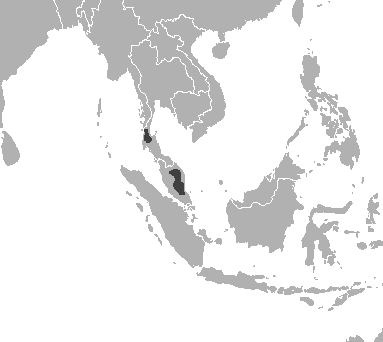The Malayan tiger is found in the southern and central parts of the Malay Peninsula home. This majestic creature symbolizes beauty and strength and is a vital part of its ecosystem.
This article delves into the Malayan tiger’s characteristics, habitat, behavior, diet, life cycle, conservation efforts, predators and threats, and taxonomy.
Quick Overview
| Weight | Males: 220-308 pounds Females: 165-245 pounds |
|---|---|
| Length | Males: ~8 feet Females: ~6.5 feet |
| Diet | Carnivore (sambar deer, wild boar, barking deer) |
| Life Span | 15-18 years in the wild, 20 -25 Years in Captivity |
| Conservation Status | Critically Endangered |
| Population | Less than 200 |
Taxonomy and Classification
The scientific journey of the Malayan tiger’s classification began with Carl Linnaeus, who named it Felis tigris in 1758.
Later, Vratislav Mazák proposed Panthera tigris corbetti in 1968 for the Southeast Asian tiger subspecies.
In 2004, Panthera tigris jacksoni was proposed as a distinct subspecies following a genetic analysis that revealed differences in mtDNA and micro-satellite sequences compared to P. t. corbetti.
Since the revision of felid taxonomy in 2017, the Malayan tiger has been recognized as a P. t. tigris population.
A 2018 genetic study further supported the Malayan tiger’s distinction from other mainland Asian tiger specimens, recognizing six monophyletic clades based on whole-genome sequencing analysis.
| Kingdom | Animalia |
|---|---|
| Phylum | Chordata |
| Subphylum | Vertebrata |
| Class | Mammalia |
| Order | Carnivora |
| Suborder | Feliformia |
| Family | Felidae |
| Genus | Panthera |
| Species | Panthera tigris |
| Subspecies | Panthera tigris tigris |
Size

The Malayan tiger is a medium-sized tiger. Adult males typically weigh between 220-308 pounds and measure almost 8 feet in length.
Females are generally smaller, weighing approximately 165-245 pounds and measuring around 6.5 feet in length.
It has a reddish-orange coat with black stripes, a natural camouflage, and like all tigers, each tiger’s stripe pattern is as unique as a human fingerprint. The retractable claws and powerful bite force are essential for hunting and survival.
Distribution and Habitat

The Malayan tiger lives in the dense forests and rugged southern and central Malay Peninsula terrains.
Once widespread across the region, habitat loss and poaching have confined them to isolated pockets.
These mixed forests provide the perfect environment for the Malayan tiger to thrive as an apex predator, maintaining the balance of the ecosystem.
Behavior

Solitary and territorial, Malayan tigers mark their domain with scent markings and can travel vast distances searching for food.
Their nocturnal nature and preference for dense forests make them elusive creatures. Communication is complex, involving a range of vocalizations, visual signals, and scent markings.
Their acute hearing and exceptional night vision enable them to navigate their environment precisely.
Hunting and Diet
As carnivorous, the Malayan tiger primarily hunts sambar deer, wild boar, and barking deer. They are nocturnal hunters, using their acute senses of hearing and sight, with night vision five times better than humans.
Their hunting technique involves stalking prey silently, using their retractable claws and powerful strength to bring it down.
Though they require 12-15 pounds of protein daily, they can consume up to 70 pounds of meat at a time, allowing them to survive when food is scarce.
Predators and Threats

While the Malayan tiger is an apex predator with no natural enemies in the wild, human activities pose significant threats.
The primary dangers are habitat loss due to deforestation, urbanization, and illegal poaching for body parts used in traditional medicine.
The black market value of tiger parts, including skin, bones, teeth, and claws, has drastically declined their numbers.
The situation worsens with human-tiger conflicts, where tigers are killed in retaliation for attacking livestock or posing threats to human settlements.
Reproduction and Life Cycle

Malayan tigers may mate year-round, leading to a gestation period of 90-115 days and litters of 2-4 cubs.
The cubs are born blind and helpless, opening their eyes within 1-2 weeks. They begin to take solid food at two months and participate in hunting at six months.
Young tigers leave their mother’s range by 1.5-3 years, with females maturing at 3-4 years and males at five. Adult Malayan tigers live up to 15-18 years in the wild.
Conservation Efforts
The Malayan tiger is now facing critical endangerment. With fewer than 200 individuals remaining in the wild, the situation is dire, and the species is classified as Critically Endangered.
- Habitat Protection: Efforts to protect and restore the tiger’s natural environment.
- Anti-Poaching Measures: Strict laws and patrolling to combat illegal trade.
- Community Engagement: Involving local communities in protection efforts.
- International Collaboration: Global cooperation to ensure survival.
- Research and Monitoring: Ongoing studies to guide conservation strategies.
- Education and Awareness: Campaigns to inspire responsibility and action.
Facts about Malayan Tiger
- National Symbol: The Malayan tiger is Malaysia’s national animal and holds significant cultural importance. It’s featured on the country’s coat of arms, symbolizing bravery and strength.
- Endangered Species: The Malayan tiger is classified as Critically Endangered by the IUCN Red List. Their numbers have been dwindling due to habitat loss and poaching.
- Distinct Subspecies: The Malayan tiger was only recognized as a separate subspecies in 2004. Before that, they were grouped with the Indochinese tiger.
- Habitat: They primarily inhabit the central and southern parts of the Malay Peninsula, away from human settlements. Their preferred habitats are forests, including both lowland rainforests and hill forests.
- Solitary Creatures: Like most tigers, the Malayan tiger is a solitary animal. They are territorial and use scent markings to establish their domain.
- Reproduction: Female Malayan tigers give birth to litters of two to four cubs, which they raise on their own. The cubs stay with their mother for up to two years before venturing out on their own.
- Threats: The primary threats to the Malayan tiger include habitat loss due to logging and development, poaching for their body parts used in traditional medicine, and human-tiger conflicts.
- Conservation Efforts: Various organizations and the Malaysian government are working towards the conservation of the Malayan tiger. Efforts include anti-poaching initiatives, habitat preservation, and awareness campaigns.
Conclusion
The Malayan tiger’s existence is a delicate blend of grace, strength, and vulnerability. Its unique characteristics, behaviors, and the challenges it faces are a testament to nature’s complexity and beauty.
As a symbol of the wilderness, the Malayan tiger reminds us of our responsibility to protect and preserve these awe-inspiring beings.
The future of this extraordinary species depends on our collective understanding, respect, and commitment to conserving its natural habitat and way of life.
FAQs
The Malayan tiger is found in the southern and central parts of the Malay Peninsula.
Malayan tigers are carnivorous predators that primarily hunt sambar deer, wild boar, and barking deer.
Adult male Malayan tigers typically weigh between 220-308 pounds, while females weigh approximately 165-245 pounds.
Adult Malayan tigers live for 15-18 years in the wild.
The Malayan tiger is distinct in its size, appearance, and genetic makeup. It’s considered one of the smaller mainland tiger subspecies and has unique genetic distinctions supported by whole-genome sequencing analysis.




